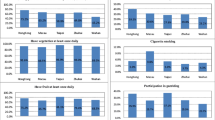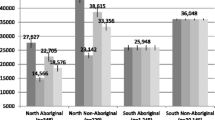Abstract
First Nations and Métis, two of Canada’s constitutionally recognized Indigenous groups, suffer from poorer overall health than non-Indigenous Canadians. Current smoking, a known predictor of chronic health conditions, is close to twice as prevalent among Indigenous youth as it is among non-Indigenous Canadian youth. However, little population-level research has examined the correlates of current smoking among this population. Guided by a health framework centered on Indigenous-specific determinants, we used data from the 2012 Aboriginal Peoples Survey to examine the correlates of current smoking among First Nations and Métis youth aged 15–17 years living outside of First Nations reserves. Using binary logistic regression, we investigated how culturally specific factors, namely knowledge of an Indigenous language, participation in traditional activities, and family members’ attendance at residential schools, were correlated with current smoking. We also considered demographic, geographic, socioeconomic and health-related correlates. Overall, an estimated 20.6% of First Nations and Métis youth reported current smoking. We found no significant associations between culturally specific activities and current smoking in the multivariate analyses, although those who spoke an Indigenous language were more likely to smoke. Those who participated in sports more often were less likely to smoke, and respondents who reported heavy drinking and who were from families with lower income were more likely to smoke. Gender, body mass index, urban/rural geography and regional geography, and mother’s highest level of education were not significantly correlated with smoking. The results of our study support prior research that has found a disturbingly high prevalence of current smoking among Indigenous youth, compared to their non-Indigenous counterparts. Our results highlight the importance of considering sports participation, co-occurring health-risk behaviours and socioeconomic factors when developing interventions aimed at reducing the prevalence of smoking among First Nations and Métis youth.
Similar content being viewed by others
Notes
Forced residential schooling of Indigenous children was a tool of assimilation in Canada from the mid-1800s, with the last institution closing in 1996. These schools have been associated with a variety of abuses and historical trauma (Truth and Reconciliation Commission of Canada, 2012).
The data for this study were provided by Statistics Canada and accessed at the South-Western Ontario Research Data Centre. The analyses and results are the authors’ alone.
Reserves are areas of Crown land set aside for use by First Nations bands. Métis have generally not been part of the reserve system. Approximately 315,000 people lived on-reserve in 2012, roughly 25% of the total Indigenous population (Statistics Canada, 2013).
A CMA is a geographic area that has a population of 100,000 people or more, with at least 50,000 people living in the core area (Statistics Canada, 2012b).
A CA is a geographic area that has a core population of at least 10,000 people (Statistics Canada, 2012b).
References
American Lung Association. (2012). Cutting tobacco’s rural roots: Tobacco use in rural communities. http://www.lung.org/assets/documents/publications/lung-disease-data/cutting-tobaccos-rural-roots.pdf. Accessed 2 May 2015.
Azagba, S., & Asbridge, M. (2013). School connectedness and susceptibility to smoking among adolescents in Canada. Nicotine & Tobacco Research: Official Journal of the Society for Research on Nicotine and Tobacco, 15(8), 1458–1463. doi:10.1093/ntr/nts340.
Barkwell, L., Dorion, L., & Hourie, A. (2006). Métis legacy. Michif culture, heritage, and folkways, vol. 2. Saskatoon: Gabriel Dumont Institute.
Berg, K. M., Piper, M. E., Smith, S. S., Fiore, M. C., & Jorenby, D. E. (2015). Defining and predicting short-term alcohol use changes during a smoking cessation attempt. Addictive Behaviors, 48, 52–57. doi:10.1016/j.addbeh.2015.04.004.
Bobo, J. K., & Husten, C. (2000). Sociocultural influences on smoking and drinking. Alcohol Research & Health: The Journal of the National Institute on Alcohol Abuse and Alcoholism, 24(4), 225–232.
Canadian Center on Substance Abuse (CCSA). (2015). Canada’s low-risk alcohol drinking guidelines. http://www.ccsa.ca/Resource%20Library/2012-Canada-Low-Risk-Alcohol-Drinking-Guidelines-Brochure-en.pdf. Accessed 15 May 2015.
Cloutier, E., & Langlet, É. (2014) Aboriginal Peoples Survey, 2012: Concepts and methods guide. http://www.statcan.gc.ca/pub/89-653-x/89-653-x2013002-eng.pdf. Accessed 30 January 2015.
Cole, T. J., Bellizzi, M. C., Flegal, K. M., & Dietz, W. H. (2000). Establishing a standard definition for child overweight and obesity worldwide: International survey. BMJ (Clinical Research Ed.), 320(7244), 1240–1243.
Cooke, M. J., Wilk, P., Paul, K. W., & Gonneville, S. L. (2013). Predictors of obesity among Métis children: Socio-economic, behavioural and cultural factors. Canadian Journal of Public Health, 104(4), e298–e303.
deRuiter, W. K., Cairney, J., Leatherdale, S. T., & Faulkner, G. E. (2014). A longitudinal examination of the interrelationship of multiple health behaviors. American Journal of Preventive Medicine, 47(3), 283–289. doi:10.1016/j.amepre.2014.04.019.
Elton-Marshall, T., Leatherdale, S. T., & Burkhalter, R. (2011). Tobacco, alcohol and illicit drug use among Aboriginal youth living off-reserve: Results from the youth smoking survey. Canadian Medical Association Journal, 183(8), E480–E486. doi:10.1503/cmaj.101913.
Fulkerson, J. A., & French, S. A. (2003). Cigarette smoking for weight loss or control among adolescents: Gender and racial/ethnic differences. The Journal of Adolescent Health: Official Publication of the Society for Adolescent Medicine, 32(4), 306–313. doi:10.1016/S1054-139X(02)00566-9.
Gionet, L., & Roshanafshar, S. (2013). Health at a glance: Select health indicators of First Nations people living off reserve, Métis and Inuit. http://www.statcan.gc.ca/pub/82-624-x/2013001/article/11763-eng.htm. Accessed 4 April 2015.
Gracey, M., & King, M. (2009). Indigenous health Part 1: Determinants and disease patterns. Lancet, 374(9683), 65–75.
Hanson, M. D., & Chen, E. (2007). Socioeconomic status and health behaviors in adolescence: A review of the literature. Journal of Behavioral Medicine, 30(3), 263–285. doi:10.1007/s10865-007-9098-3.
Health Canada. (2013). Canadian tobacco use monitoring survey (CTUMS). http://www.hc-sc.gc.ca/hc-ps/tobac-tabac/research-recherche/stat/ctums-esutc_2012-eng.php#tabc. Accessed 25 March 2015.
Health Canada. (2014): Tobacco: First Nations & Inuit health. http://www.hc-sc.gc.ca/fniah-spnia/substan/tobac-tabac/index-eng.php. Accessed 2 March 2015.
Herciu, A. C., Laxer, R. E., Cole, A., & Leatherdale, S. T. (2014). A cross-sectional study examining factors associated with youth binge drinking in the COMPASS study: Year 1 data. Journal of Alcoholism & Drug Dependence, 2, 172. doi:10.4172/2329-6488.1000172.
Horn, K., Dino, G., Branstetter, S. A., Zhang, J., Noerachmanto, N., Jarrett, T., et al. (2011). Effects of physical activity on teen smoking cessation. Pediatrics, 128(4), e801–e811. doi:10.1542/peds.2010-2599.
Janz, T., Seto, J., & Turner, A. (2009). Aboriginal Peoples Survey, 2006: An overview of the health of the Métis population. Ottawa, Ontario. http://www.statcan.gc.ca/pub/89-637-x/89-637-x2009004-eng.htm. Accessed 22 March 2015.
Johnson, P. B., Boles, S. M., Vaughan, R., & Kleber, H. D. (2000). The co-occurrence of smoking and binge drinking in adolescence. Addictive Behaviors, 25(5), 779–783.
King, M., Smith, A., & Gracey, M. (2009). Indigenous health Part 2: The underlying causes of the health gap. Lancet, 374(9683), 76–85.
Larson, N. I., Story, M., Perry, C. L., Neumark-Sztainer, D., & Hannan, P. J. (2007). Are diet and physical activity patterns related to cigarette smoking in adolescents? findings from project EAT. Preventing Chronic Disease, 4(3), A51.
Leatherdale, S. T., & Rynard, V. (2013). A cross-sectional examination of modifiable risk factors for chronic disease among a nationally representative sample of youth: Are Canadian students graduating high school with a failing grade for health? BMC Public Health. doi:10.1186/1471-2458-13-569.
Leatherdale, S. T., Wong, S. L., Manske, S. R., & Colditz, G. A. (2008). Susceptibility to smoking and its association with physical activity, BMI, and weight concerns among youth. Nicotine & Tobacco Research: Official Journal of the Society for Research on Nicotine and Tobacco, 10(3), 499–505. doi:10.1080/14622200801902201.
Lowry, R., Galuska, D. A., Fulton, J. E., Wechsler, H., & Kann, L. (2002). Weight management goals and practices among U.S. high school students: Associations with physical activity, diet, and smoking. The Journal of Adolescent Health: Official Publication of the Society for Adolescent Medicine, 31(2), 133–144. doi:10.1016/S1054-139X(01)00408-6.
Mitrou, F., Cooke, M., Lawrence, D., Povah, D., Mobilia, E., Guimond, E., et al. (2014). Gaps in indigenous disadvantage not closing: A census cohort study of social determinants of health in Australia, Canada, New Zealand from 1981–2006. BMC Public Health. doi:10.1186/1471-2458-14-201.
Paxton, R. J., Valois, R. F., & Drane, J. W. (2004). Correlates of body mass index, weight goals, and weight-management practices among adolescents. The Journal of School Health, 74(4), 136–143.
Plotnikoff, R. C., Bercovitz, K., & Loucaides, C. A. (2004). Physical activity, smoking, and obesity among Canadian school youth. Comparison between urban and rural schools. Canadian Journal of Public Health, 95(6), 413–418.
Potter, B. K., Pederson, L. L., Chan, S. S., Aubut, J. A., & Koval, J. J. (2004). Does a relationship exist between body weight, concerns about weight, and smoking among adolescents? An integration of the literature with an emphasis on gender. Nicotine & Tobacco Research: Official Journal of the Society for Research on Nicotine and Tobacco, 6(3), 397–425. doi:10.1080/14622200410001696529.
Reiner, M., Niermann, C., Jekauc, D., & Woll, A. (2013). Long-term health benefits of physical activity–a systematic review of longitudinal studies. BMC Public Health. doi:10.1186/1471-2458-13-813.
Richmond, C. A., & Ross, N. A. (2009). The determinants of First Nation and Inuit health: A critical population health approach. Health & Place, 15(2), 403–411. doi:10.1016/j.healthplace.2008.07.004.
Ryan, C. J., Cooke, M., Leatherdale, S. T., Kirkpatrick, S. I., & Wilk, P. (2015). The correlates of smoking among adult Métis: Evidence from the Aboriginal Peoples Survey and Métis supplement. The Canadian Journal of Public Health, 106(5), e271–e276. doi:10.17269/CJPH.106.5053.
Soto, C., Baezconde-Garbanati, L., Schwartz, S. J., & Unger, J. B. (2015). Stressful life events, ethnic identity, historical trauma, and participation in cultural activities: Associations with smoking behaviors among American Indian adolescents in California. Addictive Behaviors, 50, 64–69.
Soulakova, J. N., Bright, B. C., & Crockett, L. J. (2013). On consistency of self- and proxy-reported regular smoking initiation age. Journal of Substance Abuse and Alcoholism, 1(1), 1001.
Statistics Canada. (2012a). The Aboriginal Peoples Survey. http://www23.statcan.gc.ca/imdb/p2SV.pl?Function=getSurvey&SDDS=3250&lang=en&db=imdb&adm=8&dis=2. Accessed 3 April 2015.
Statistics Canada. (2012b). Census dictionary. Canada: Minister of Industry, 2013. https://www12.statcan.gc.ca/census-recensement/2011/ref/dict/98-301-X2011001-eng.pdf. Accessed 30 January 2015.
Statistics Canada. (2013). 2011 National Household Survey: Aboriginal Peoples in Canada: First Nations People, Métis and Inuit. http://www12.statcan.gc.ca/nhs-enm/2011/as-sa/99-011-x/99-011-x2011001-eng.cfm. Accessed 14 May 2015.
Statistics Canada. (2014). Heavy drinking, 2013. Statistics Canada Catalogue No. 82-625-X. Ottawa. http://www.statcan.gc.ca/pub/82-625-x/2014001/article/14019-eng.htm. Accessed 29 December 2014.
Tewolde, S., Ferguson, B. S., & Benson, J. (2006). Risky behavior in youth: An analysis of the factors influencing youth smoking decisions in Canada. Substance Use and Misuse, 41(4), 467–487. doi:10.1080/10826080500521730.
Truth and Reconciliation Commission of Canada. (2012). Canada, Aboriginal Peoples and residential schools: They came for the children. Winnipeg: The Commission. https://www.aadnc-aandc.gc.ca/DAM/DAM-INTER-HQ-AI/STAGING/texte-text/abo_demo2013_1370443844970_eng.pdf.
Wilson, K., & Rosenberg, M. W. (2002). Exploring the determinants of health for First Nations peoples in Canada: Can existing frameworks accommodate traditional activities? Social Science & Medicine. (1982), 55(11), 2017–2031.
Windle, M. (2003). Alcohol use among adolescents and young adults. Population, 45(5.9), 19.
Acknowledgements
Funding was provided by operating grants from the Canadian Institutes of Health Research (CIHR) and Public Health Agency of Canada (PHAC, Grant No. 329323).
Author information
Authors and Affiliations
Corresponding author
Ethics declarations
Conflict of Interest
The authors declare that they have no conflict of interest.
Rights and permissions
About this article
Cite this article
Ryan, C., Leatherdale, S. & Cooke, M. Factors Associated With Current Smoking Among Off-Reserve First Nations and Métis Youth: Results From the 2012 Aboriginal Peoples Survey . J Primary Prevent 38, 105–119 (2017). https://doi.org/10.1007/s10935-016-0456-1
Published:
Issue Date:
DOI: https://doi.org/10.1007/s10935-016-0456-1




